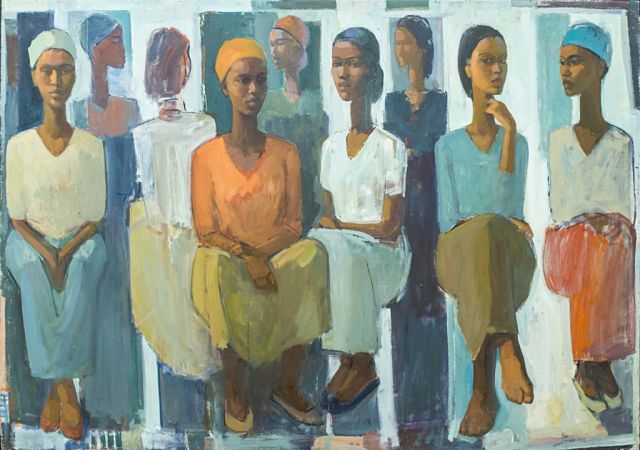 Tadesse Mesfin, Pillars of Life: Market Day (2018). Courtesy Addis Fine Art.
Tadesse Mesfin, Pillars of Life: Market Day (2018). Courtesy Addis Fine Art.
Tadias Magazine
By Tadias Staff
Published: October 9th, 2019
New York (TADIAS) — In a feature published this week, highlighting the growing African art scene in the global market, Artnet News website lists Addis Ababa among six dynamic emerging art capitals on the African continent.
Art institutions in Addis Ababa mentioned in the publication as leading this renaissance include “Alle School of Fine Art & Design (Ethiopia’s most important art school..founded in 1958, during the reign of Emperor Haile Selassie, and has educated the country’s preeminent painters, sculptors, printmakers, and designers); Addis Fine Art (The most notable commercial gallery in the capital and its first white-cube art space, Addis regularly showcases graduates from the Alle School, and will open a new location in London’s Cromwell Place gallery hub in 2020); Guramane Art Center (A gallery dedicated to emerging Ethiopian artists, it represents the vanguard of the country’s art scene); and Zoma (this sprawling museum, founded by artist Elias Sime and curator Meskerem Assegued, opened in April 2019 and shows contemporary art from East Africa and abroad).”
The other art capitals featured in the Artnet News article include Accra, Cape Town, Dakar, Lagos, and Marrakech.
“Today, Africa’s art market has plenty of room to grow. Fewer than 1,000 works were sold at auction on the continent in the first six months of 2019, according to the artnet Price Database,” Artnet News notes, and adds: “Unlike Asia, where Hong Kong has emerged as a hub for the trade, Africa lacks a preeminent art-market capital. And while the continent’s local collector base is growing steadily—Sotheby’s fourth dedicated auction of Modern and contemporary African art in April was dominated by African buyers and generated a total of $3 million, above its presale high estimate of $2.7 million— it is still nascent compared with the U.S., China, and Europe.”
Artnet quotes Hannah O’Leary, Head of Modern and Contemporary African Art at Sotheby’s who shares that “we are seeing lots of raw talent, but we need more of a market structure in order to support their careers.’”
Regarding Addis Ababa as an art capital, Artnet states:
Coptic art, shaped by the 1,500-year history of the Ethiopian Orthodox Tewahedo Church, is one of the country’s major artistic influences and continues to be practiced by numerous artisans. But the 20th century also witnessed three distinct artistic movements that remained popular until the Ethiopian Revolution of 1974: a realistic, or “naïve,” style used to depict glamorous Ethiopian society; abstraction, which incorporated influences from Western Expressionism and Surrealism; and social realism, which was political in subject matter and focused largely on urban scenes and the struggling masses.
Home to more than 112 million people, Ethiopia is the second-most populous country on the continent. According to the International Monetary Fund, Ethiopia’s economy is expected to grow 8.5 percent this fiscal year, making it the fastest-growing economy in Sub-Saharan Africa.
Despite the difficulty in obtaining art materials, which must be either imported from abroad or made at home, today’s artists work largely in paint, together with photography and sculpture using found objects. “A lot of people use art for commercial or propaganda purposes, and I hope that our government understands the power of supporting our artists and preserving our culture,” says Melaku Belay, founder of the Fendika Cultural Center. “We need to think of the past if we want to go to the future.”
See the full list at news.artnet.com »
—
Join the conversation on Twitter and Facebook.

























